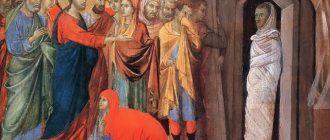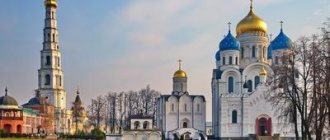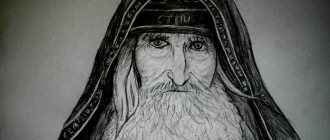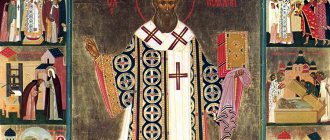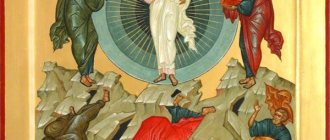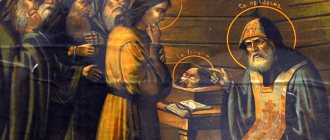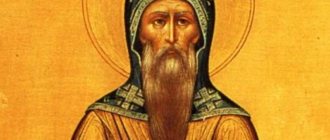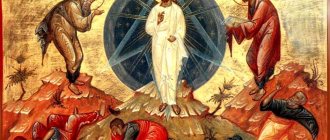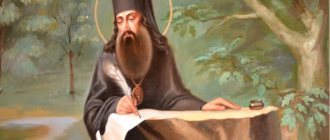MAKARIUS
M., appointed by the Synod to the position of head of the ADM, August 3. 1830, together with Popov and Volkov, left Tobolsk and on August 29. arrived in Biysk, which became the central point of the mission for several months. It's already September 7th. all L. Ulala M. baptized the young Altai man Eleska with the name John. It was this date that the Altai missionaries considered the day of the founding of the ADM and the day of memory of its founder. M. devoted the first six months of his ministry to traveling around the villages of the Altai Mountains. He got acquainted with the local residents, their dialects, and also looked for the most convenient point for the central camp of the mission. In Feb. In 1831, in order to be closer to the nomadic tribes of the Altai Mountains, M. moved from Biysk to the Saidyp Cossack outpost, and in May 1831 to Ulala. But, having learned that the residents of Ulala, not wanting to be baptized, intended to migrate to the Kuznetsk district, on May 23 M. retired to a nearby village. Maima, where he opened the 1st missionary camp. Here he began to get acquainted not only with the Ulalin Teleuts, but also with representatives of other Altai tribes due to the favorable location of the village “at the entrance to the region of the Chernov Tatars and nomadic... Kalmyks” (Lavrov. 1860. P. 65).
The mission helped the newly baptized to build houses, supplied them with clothing and equipment. While engaged in arranging and improving the settled life of the Altai flock, M. became interested in agriculture and gardening, subscribed to the necessary books and magazines, as well as seeds of various vegetables, medicinal herbs and flowers, which he supplied to the poor Altai people. M. also took care of the health of his flock, learned to vaccinate smallpox, and collected medicinal herbs.
M.'s service, filled with compassion for foreigners, changed the attitude of the Ulala residents towards him, and by 1834 most of them were baptized. In 1834, the archimandrite moved to the village of Ulala, which became the central camp of the ADM. Having 2 antimensions for camp churches (one for the church in the name of the All-Merciful Savior, the other for the church in honor of the Smolensk Icon of the Mother of God), M. served alternately in Ulala and Mayma, and from 1839 in Myuta. By 1836, almost all residents of Ulala were baptized.
With particular strictness, M. monitored the regular attendance of the newly baptized on Sunday and holiday services. And although during his service in the ADM he did not manage to introduce divine services in the Altai language, he tried with all his might to make it understandable for foreigners. After 2 years of serving in the mission, M. could talk with the Altai people in their native language: explain Christ. doctrinal and moral truths, talk about the events of the Holy. history, teach church singing. In the “Notes of Archimandrite Macarius and his brethren, who was in the Biysk district for the conversion of infidels to Christianity,” for 1832 it was reported: “We can offer to foreigners the essential teaching of the Christian faith and invite them to the Church of Christ in the dialect of the Black Tatars and Altaians, but in an arrangement of the Holy Scriptures they were not able to take even a step without an interpreter” (quoted from: Kharlampovich. 1905. No. 10. P. 496). M. often conducted extra-liturgical interviews with the newly baptized. Through translators and interpreters, he asked about their needs and concerns, offered “decent advice and necessary instructions,” and taught them to sing spiritual songs of praise—cants—from the collection he compiled, “Mite.”
The archimandrite’s special concern was teaching Altai children to read and write and establishing missionary schools for them. In the 30s XIX century the founder of ADM opened the first schools in Altai: 2 for boys and one for girls. Mission employee Fr. (later archpriest) Vasily Verbitsky, having collected information in the ADM archive about the beginning of schooling in Altai, about (GAAK. F. 164. Op. 1. D. 5. L. 14 vol., 1860).
All L. Maima, assistant to the Reverend Sophia de Valmont, who arrived in 1840, taught the girls reading, singing and basic arithmetic. The education of boys in both mission camps was carried out by Altai missionaries. At first M. also taught children in Mayma and Ulala. According to the recollections of one of the students, he talked with them on various topics from the Holy Scriptures. stories, learned and sang prayers. After classes, M. played with the children, even “running races with them.” M.'s student was the Altai missionary Archpriest. Mikhail Chevalkov, who in his “Memorable Testament” spoke in detail about the lessons of the monk. Missionary of the Condom branch of the ADM priest. I.M. Shtygashev wrote in his report that “Archimandrite Macarius tried to closely connect the school with life, to arrange it so that it would be the soul of both children and adults. Through children, he influenced the education of the parents themselves. For this purpose, the teaching was presented in such a way that the children passed on to their parents what they heard and learned” (Ibid. D. 55. L. 53).
From the very beginning of his service in the mission, M. intended to create the Altai alphabet. Since the peoples inhabiting the Altai Mountains did not yet have a national written language, M., having studied various dialects, developed the Altai alphabet based on the Cyrillic alphabet. In missionary schools, children were taught Altai literacy, the Law of God, church singing, and arithmetic. At first, teaching was conducted in the Altai language, but over time M. decided that in order to introduce foreigners to the Orthodox Church. culture requires “teaching the newly baptized to read and write not only their natural dialects, but also Slavic and Russian” (Letters. 1905. P. 151). At the turn of the 30s and 40s. XIX century he compiled a “children’s book” - a primer called “Elementary teaching for a person who wants to learn the book of Divine Scripture.” In addition to the Russian-Slavic alphabet, the primer includes a short prayer book and a catechism, consisting of texts from the Holy Spirit. Scriptures in Russian. On Dec. 1841 M. sent a letter to St. Filaret with a request to help “find funds for the printing of this book.” In the same letter, he reported: “The mission is preparing for presentation to the church authorities an alphabet in the Teleut dialect, in accordance with this Slavic and Russian alphabet, which is closely related to all other dialects of the local foreigners and understandable to all of them” (Ibid. pp. 151-152 ). However, the missionary never succeeded in publishing the “children’s book.” In a reply letter to St. Filaret explained: “I don’t know what to do with your “Elementary Teaching”. Now, more than ever, they are forbidden to replace Slavic with Russian” (Filaret (Drozdov), Metropolitan. Letters to the Highest Persons and various other persons. Tver, 1888. Part 1. P. 133). The first printed Altai “Primer for teaching the children of baptized Altai foreigners church and civil reading” was published only in 1868.
In Altai, M.'s talent as a translator was fully revealed. Back in July 1830 in Tobolsk, Archbishop. Evgeniy issued instructions to the head of the ADM and his first employees, which contained an entire missionary translation program: “When communicating among foreigners, recommend that he, Father Archimandrite, and the seminarians who will be with him learn their language and learn their customs and faith; and as soon as they achieve sufficient knowledge of their language, translate into it the books of the Holy Scriptures, firstly the New Testament, the Psalter and, in addition to these, the Creed, the Lord’s Prayer, the commandments, the catechism and some, optionally, the lives of the holy fathers.”
The difficulties in studying the numerous dialects of the peoples of Altai are evidenced by M.’s entry in his travel diary for 1830-1833: “Until now, we seemed to be walking around the world and begging: the collection of Tatar words and sayings we accumulated was likened to a beggar’s bag, in which pieces of all kinds of bread, and soft and stale, and wheat and rye, and fresh and rotten - everything is mixed indiscriminately, and all together makes up a heavy burden... Such were our spoils in getting to know the various dialects used in various tribes of foreigners. There was information gleaned from various sources that we encountered on our way... Here were the words of the Kumandins, Chernov Tatars, Teleuts, Altaians” (quoted from: Kharlampovich. 1905. No. 10. pp. 495-496). 3 months after his arrival in Altai, M. was already bringing, “as much as possible, into order the words and expressions of adverbs used by the local infidels, and experiments in translations from Russian into them.” Afterwards he compiled a lexicon containing up to 3 thousand words.
During his entire stay in Altai (1830-1844), M., with the help of translators and interpreters, translated into the local dialect, mainly Teleut, almost the entire Gospel, selected passages from the books of the Old Testament, the Acts of St. apostles and apostolic epistles, including the entire First Epistle of St. John the Theologian, church hymns and psalms, the most important prayers, Short Catechism of St. Philaret, catechetical teaching, Creed, 10 commandments with interpretations, brief Holy Scripture. history, questions asked at baptism, etc.
In 1885, Prot. Vasily Verbitsky wrote about the manuscripts of M.’s translations into the Altai language that, “looking at the huge notebooks of his translations into the language of the Altai foreigners, one cannot help but be surprised by his tireless activity” (Essay on the activities of the Altai spiritual mission on the occasion of its 50th anniversary // Memorial Book Tomsk province for 1885. Tomsk, 1885. P. 220). In 1886, the Biysk bishop's house was set on fire; According to the missionaries, “mountains of manuscripts” of the founder of the mission were burned in the fire.
Realizing the high importance of missionary activity, M. took care of the full preparation of future “religious preachers.” When in 1836 the Synod invited the monk to move to the Irkutsk diocese to preach to the Buryats, M. replied that he wanted to “devote the remains of his strength to preparing two young men ... for the most fruitful preaching of the Gospel not only to pagans, but also to Jews and Mohammedans.” M. also presented the “method of this preparation”: for 3-4 years he, together with the mission staff (S. Landyshev and M. Nigritsky), needs to stay in Moscow in order to “stock up on things needed for the missionary service” at the university and other educational institutions knowledge, for example, to get acquainted with the Arabic language, the original Alkoran, natural history and physics, anatomy and other medical sciences, without forgetting the philosophical and theological.”
In Feb. 1838 M. submitted a petition to the bishop. Tomsk and Yenisei Agapit (Voznesensky) about leaving for Russia “to improve” his health and in order to explain himself to the highest church authorities in St. Petersburg, as well as about further service in a missionary rank. In preparation for his trip to St. Petersburg, he compiled a missionary project - “Thoughts on ways to successfully spread the Christian faith among Jews, Mohammedans and pagans in the Russian state,” in which he summarized the experience of his ministry. The initial plan for training missionaries, proposed by him back in 1836, in this work was brought to a detailed system for organizing missionary work in Russia. In Jan. 1839, on the eve of a trip to St. Petersburg, M. handed over the manuscript to Bishop. Agapit to present it to the Synod. As he himself explained, “for faithful preservation,” since “on the way... I might die” (Ibid. p. 201). Dr. list of the project along with Russian. translation of the Book of the Prophet. Isaiah, prepared in 1838, he sent to the imp. Nicholas I.
31 Jan 1839 M. left for St. Petersburg. He decided to use his stay in the capital not only to promote the missionary project, but also to obtain permission to publish the Bible in Russian translation. However, the project of organizing missionary work in Russia was not approved by the Synod. 14 Apr 1839 The Synod decided: M.’s request “to be left without action, the manuscripts to be returned to the Right Reverend Tomsky by decree.” The persistence with which M. petitioned for the publication of the Bible in Russian. language, led to the fact that on May 11 a new synodal decree was issued: M. must go to his place of service in the Tomsk diocese with the right to stay in Moscow for 2-3 months for treatment. In St. Petersburg and Moscow, the archimandrite managed to make many new acquaintances and enlist their support for the missionary work. In Moscow, a significant amount of donations was collected for the needs of ADM - approx. 10 thousand rubles In addition, it was possible to find 2 new employees for the mission. They were a student of the veterinary department of the Moscow Medical-Surgical Academy A. G. Levitsky (later abbot Akakiy) and S. de Valmont, a graduate of the Smolny Institute.
On March 8, 1840, M. left Moscow with new mission employees. They arrived at the mission only on July 20, on the way stopping in Kazan, where at the Kazan University the Altai missionaries studied the Tatar and Mongolian languages for 3 months, and also listened to lectures on anatomy, botany and even astronomy. Here the head of the ADM met N.I. Lobachevsky and other scientists from Kazan University. At the same time, he underwent a course of treatment.
In recent years of service in ADM, the reverend has significantly expanded the mission's activities. Largely thanks to the donations brought from Moscow, the Ulalinsky camp was equipped, the missionaries began building the 3rd camp church and opened a school for Altai girls in Mayma. During the 13 years and 8 months of management of the M. Altai mission, 675 adult foreigners and 1047 children were baptized. M. raised a whole galaxy of educational missionaries, the total number of mission employees was 18 people. His associates were: seminarians Popov and Volkov; hieromonks Anastasius and Parfeniy; priests Alexy Ionin, Alexy Glukharev (brother of Macarius), Vasily Vessky, Mikhail Chevalkov, Stefan Landyshev; students of theological schools Negritsky and T. Ekzertsev; abbot. Akaki (Levitsky), deacon Pyotr Tarbaev, exiled settler P. Lisitsky, retired soldier A. Orlov (later schema monk. Macarius), peasant F. Gilev, P. Landysheva (stepmother of priest S. Landysheva) and S. de Valmont. Some of them served in the ADM for a short time, others were abbots. Akakiy (Levitsky; † 1874), archpriests S. Landyshev († 1882) and M. Chevalkov († 1901) — devoted their entire lives to missionary service.
M. did not take credit for the conversion of the Altaians. Having learned about the impending awarding of the Order of St. Anna of the 3rd degree, February 12. 1834 he submitted a report to the archbishop. Afanasy Tobolsky with a request “not to decorate his services” with any “difference”, but to allocate funds to help the needy newly baptized. This request was granted, but instead of an order in 1835, by the highest command, M. was awarded a pectoral gold cross decorated with precious stones.
In con. Dec. 1842 M. submitted a petition to the Synod for his release from the post of head of the ADM, citing poor health, especially his eyesight (Letters. 1905. P. 467). On June 16, 1844, by decree of the Synod, M. was released from leadership of the mission and appointed rector of the Optina Bolkhov monastery of the Oryol diocese. On July 4, 1844 M. left for Bolkhov. According to the recollections of cell attendant A. Orlov, with whom the archimandrite set off on the journey, the Mayminians and Ulali residents, who saw off their shepherd, were still approx. They walked 5 miles “with screams and sobs,” trying to hold the carriage and stop the horses.
The fate of Metropolitan Macarius after the revolutionary riot of 1917
The Metropolitan had to leave the Trinity-Sergius Lavra for the Smolensk Zosimov hermitage.
From there he was asked to go to the Nikolo-Ugreshsky Monastery in the Moscow region.
8 years
Bishop Macarius lived in captivity in the monastery
The Metropolitan submitted a petition to the All-Russian Local Council, at which he was rehabilitated. However, the Lord was not released from captivity.
After 3 years, he was awarded the lifelong title of Metropolitan of Altai.
The Metropolitan was visited twice and searched. He was attacked by armed bandits who threatened him with violence.
Appearance of the late mother to the Metropolitan, blessed death
Several times Macarius tried to move to other places to continue his pastoral work.
One night in a dream he saw his mother putting hooks on all the doors of his house. The Metropolitan took this as a sign and abandoned his desire to leave the monastery.
1920
this year Vladyka was partially paralyzed
Until the end of his days, Metropolitan Macarius received his spiritual children and performed divine services and followed all the statutory rules.
His Holiness Patriarch Tikhon and other hierarchs and priests visited him. One of his visitors wrote:
“It was a difficult time, we all wanted to strengthen ourselves near the lamp of Orthodoxy - Master Macarius,
so that we may stand in the truth if we are put to the test.”
After the closure of the Nikolo-Ugreshsky Monastery, Vladyka spent the last year of his life in the village of Kotelniki near Lyubertsy.
In February 1926, he fell ill with pneumonia. Feeling his death approaching, the elder took unction. His Eminence Arseny, who read the funeral service over the dying man, wrote:
“I had barely finished when the saint of God, taking a deep breath, quietly gave up his spirit to the Lord...”
The funeral liturgy and funeral service were performed by Archbishop Innocent, six bishops and 79 priests. Vladyka was buried near the altar of the church in the village of Kotelniki.
Temple in honor of the Kazan Icon of the Mother of God. Kotelniki, near whose walls Metropolitan Macarius rested. Photography of the first half of the twentieth century
On April 16, 1957, the commission opened the grave of Vladyka. The coffin turned out to be destroyed, and the vestments and body turned out to be incorrupt.
The Metropolitan's body was buried in the lower part of the Assumption Cathedral in the Holy Trinity Sergius Lavra.
In 2000, at the Council of Bishops, Metropolitan Macarius was canonized.
Reliquary with the relics of St. Macarius of Nevsky. Trinity-Sergius Lavra, Assumption Cathedral
Memorable dates
| date | Event |
| October 1, 1835 | Birthday |
| 1854 | Graduated from theological seminary |
| February 22, 1955 | Entered the Altai Spiritual Mission |
| January 25, 1857 | He was tonsured into the ryassophore |
| March 11, 1861 | Took monastic vows |
| March 19, 1961 | Ordained as hieromonk |
| 1867-68 | Work in St. Pererburg |
| 1868-69 | Work in Kazan |
| 1871 | Elevated to the rank of abbot |
| 1883 | Elevated to the rank of archimandrite |
| February 12, 1884 | Ordained bishop |
| May 26, 1891 | Appointed Bishop of Tomsk and Semipalatinsk |
| October 27, 1895 | Honorary member of the Kazan DS |
| May 6, 1903 | Awarded the Diamond Cross |
| May 6, 1906 | Elevated to the rank of archbishop |
| November 25, 1912 | Appointed to the Moscow Metropolis |
| March 20, 1917 | Fired for staff |
| 1917 | Exiled to the Nikolo-Ugreshsky Monastery |
| August 19, 1920 | Awarded the lifelong title of Metropolitan of Altai |
| 1920 | Partially paralyzed |
| 1925 | Moving to the village Kotelniki |
| March 1, 1926 | Blessed death |
| 2000 g | Canonized |
A modern icon of St. Macarius of Nevsky with a piece of his coffin.
Temple of the Savior Not Made by Hands, p. Kargasok Preachers, missionaries and everyone who wants to know and establish themselves in the Orthodox faith turn to the saint for help.
Troparion to Saint Macarius, Metropolitan of Moscow and Altai
Voice 4
By preaching the Divine faith, you illuminated the land of Siberia,
exuding warmth and light of Christ,
You brought many people to Christ,
You have appeared to the capital city of Moscow and all Russia, a glorious adornment,
jealous of the apostolic act,
You built the Church of Christ, / our good shepherd Saint Macarius,
pray to Christ God to save us all.
Monument to Metropolitan Macarius in the city of Biysk. Opened in 2009. Sculptor Sergey Isakov
By leaving a comment, you accept the user agreement
